|
Volume 2013/14, Issue 10
| February 12, 2014 |
|

Salmonid Restoration Conference
March 19-22
Cal-Neva AFS Conference
March 27-29
Central Valley Tour
April 23-25
|
|
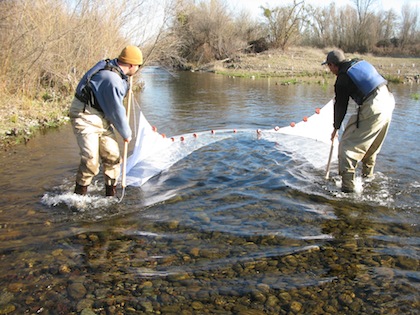
|
Key Highlights
January 13, 2014 - February 2, 2014
Calaveras River Juvenile Migration Monitoring continued at Shelton Road (RM 28) and a total of 31 O. mykiss were captured, increasing the season total to 112.
Stanislaus River Juvenile Migration Monitoring continued at Oakdale (RM 40) and a total of 31,669 Chinook salmon were captured, increasing the season total to 32,490.
Tuolumne River Juvenile Migration Monitoring continued at Waterford (RM 30) and a total of 657 Chinook salmon were captured, increasing the season total to 661. No Chinook salmon were captured at Grayson (RM 5).
Mokelumne River Juvenile Migration Monitoring continued at Vino Farms (RM 54) and a total of 4,462 Chinook salmon were captured, increasing the season total to 5,370. Monitoring continued at Golf (RM 38) and a total of 26 Chinook salmon were captured, increasing the season total to 27.
Stanislaus River Weir Monitoring continued and 5,457 Chinook salmon have passed upstream through the weir this season.
Tuolumne River Weir Monitoring continued and 3,738 Chinook salmon have passed upstream through the weir this season.
Mokelumne River Woodbridge Dam Fish Ladder Monitoring continued and 12,277 Chinook salmon passed upstream of the dam this year.
San Joaquin River Conditions. San Joaquin River flow at Vernalis ranged from 682 cfs to 983 cfs. Daily average water temperature in the San Joaquin River ranged from 48.9°F to 56.6°F at Vernalis, and from 49.6°F to 56.8°F at Mossdale. Daily average dissolved oxygen (DO) in the San Joaquin River ranged from 10.3 mg/L to 12.4 mg/L at Mossdale, and from 10.2 mg/L to 11.5 mg/L in the deep-water ship channel (measured at Rough 'n Ready Island).
Delta Exports. Combined total exports (state and federal pumps) fluctuated during the reporting period, ranging from 481 cfs to 1,642 cfs.
|
|
2013/14 Calaveras River Juvenile Migration Monitoring
The Calaveras River rotary screw trap at Shelton Road (RM 28) operated twelve days between January 13 and February 2 and a total of 31 O. mykiss were captured,  increasing the season total to 112. Daily catches ranged from 0 to 6 individuals (Figure 1), and most O. mykiss captured were Age 1+ (100-299 mm) and were rated as parr (n=1), silvery parr (n=27) and smolt (n=2) but one adult O. mykiss was captured. Average forklengths and weights of O. mykiss are provided in Table 1. increasing the season total to 112. Daily catches ranged from 0 to 6 individuals (Figure 1), and most O. mykiss captured were Age 1+ (100-299 mm) and were rated as parr (n=1), silvery parr (n=27) and smolt (n=2) but one adult O. mykiss was captured. Average forklengths and weights of O. mykiss are provided in Table 1.
No Chinook salmon were captured and the season total remains at eleven.
Instantaneous temperature recorded at the trap ranged from 45.1ºF to 53.1ºF, and turbidity ranged from 0.62 NTU to 2.17 NTU. During the reporting period, daily average combined flow from New Hogan Dam (NHG) and Cosgrove Creek (COS) was stable between 28 cfs and 31 cfs, and at Bellota (MRS) flow ranged between 1 cfs and 10 cfs (Figure 1).
Table 1. Biosampling data for O. mykiss captured at Shelton Road between January 13, 2014 and February 2, 2014. Parenthesis indicates range.
Figure 1. Daily O. mykiss catch at Shelton Road, and Calaveras River flow recorded by New Hogan Dam (NHG) and Cosgrove Creek (COS) combined and flow recorded at Bellota (MRS), in 2013.
|
2014 Stanislaus River Juvenile Migration Monitoring
Stanislaus River rotary screw trap at Oakdale (RM 40) continued and a total of 31,669 Chinook salmon were captured, increasing the season total to 32,490. Average forklengths and weights of all Chinook salmon are provided in Table 2. Most of the fish measured were fry (n = 1,315), but parr (n=5) and smolt (n=14) were also captured.
Table 2. Biosampling data for Chinook salmon captured and measured at Waterford between January 13, 2014 and February 2, 2014. Parenthesis indicates range.
 Four O. mykiss were captured during the reporting period, increasing the season total to five. Four O. mykiss were captured during the reporting period, increasing the season total to five.
Instantaneous temperature taken at the trap ranged from 44.9ºF to 52.3ºF, and turbidity ranged from 0.48 NTU to 3.06 NTU. Daily average flow at Goodwin Dam (GDW) ranged from 204 cfs to 616 cfs, and flow ranged from 227 cfs to 475 cfs at Ripon (RIP) (Figure 2).
Five trap efficiency evaluations were conducted during the reporting period with naturally spawned juvenile Chinook salmon marked caudal fin green (CFG).
Preliminary estimates of capture efficiency are provided in Table 3.
Table 3. Trap efficiency tests conducted at Oakdale between January 13 and February 2, 2014.
Figure 2. Daily O. mykiss catch at Shelton Road, and Calaveras River flow recorded by New Hogan Dam (NHG) and Cosgrove Creek (COS) combined and flow recorded at Bellota (MRS), in 2013.
|
2014 Tuolumne River Juvenile Migration Monitoring
Tuolumne River rotary screw trap at Waterford (RM 30) continued and a total of 657 Chinook salmon were captured, increasing the season total to 661. Average forklengths and weights of all Chinook salmon are provided in Table 4. Most of the fish measured were fry (n=458), but parr (n=2) and smolt (n=7) were also measured.
Table 4. Biosampling data for Chinook salmon captured and measured at Waterford between January 13 and February 2, 2014. Parentheses indicate range.
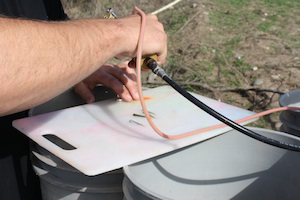 No O. mykiss were captured during the reporting period. No O. mykiss were captured during the reporting period.
Instantaneous temperature taken at the trap ranged from 48.0ºF to 57.0ºF, and turbidity ranged from 0.26 NTU to 2.77 NTU. Daily average flow at La Grange (LGN) was stable between 160 cfs and 167 cfs (Figure 3).
Two trap efficiency evaluations were conducted during the reporting period with naturally spawned juvenile Chinook salmon marked caudal fin orange (CFO). Preliminary estimates of capture efficiency are provided in Table 5.
Table 5. Trap efficiency tests conducted at Waterford between January 13 and February 2, 2014.
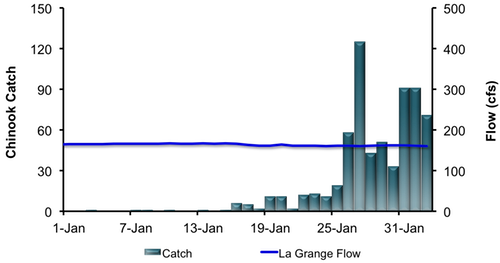
Figure 3. Daily Chinook salmon catch at Waterford and Tuolumne River flow recorded at La Grange (LGN) between January 1, and February 2, 2014.
Tuolumne River rotary screw traps at Grayson (RM 5) sampled five days during the reporting period and no Chinook salmon have been captured.
Instantaneous temperature taken at the trap ranged from 53.6ºF to 57.6ºF, and turbidity ranged from 0.51 NTU to 2.63 NTU. Daily average flow at Modesto (MOD) was stable during the reporting period, ranging between 185 cfs and 224 cfs.
|
2013/14 Mokelumne River Juvenile Migration Monitoring
Mokelumne River rotary screw trap at Vino Farms (RM 54) continued sampling intermittently during the reporting period. A total of 4,462 juvenile Chinook salmon were captured, increasing the season total to 5,370.
Average daily flow from Camanche Reservoir (CMN) ranged from 254 cfs to 258 cfs (Figure 4). Instantaneous temperature ranged between 48.0°F and 51.6°F, and instantaneous turbidity ranged between 1.45 NTU and 2.00 NTU.
Figure 4. Daily juvenile Chinook catches at Vino Farms and Mokelumne River flow recorded at Camanche Reservoir (CMN), between December 1, 2013, and February 2, 2014.
Mokelumne River rotary screw trap at Golf (RM 38) continued sampling intermittently during the reporting period. A total of 26 Chinook salmon were captured, increasing the season total to 27 (Figure 5).
Instantaneous temperature ranged between 48.2°F and 53.1°F, and instantaneous turbidity ranged between 1.32 NTU and 2.07 NTU.
Figure 5. Daily juvenile Chinook catches at Golf and Mokelumne River flow recorded at Camanche Reservoir (CMN), between January 1, and February 2, 2014.
|
2013 Stanislaus River Weir Adult Migration Monitoring
A total of 14 Chinook salmon were detected passing upstream of the Stanislaus River Weir (RM 31) between January 13 and February 2, increasing the season total to 5,457 (Table 6). Daily passage ranged between 0 and 3 Chinook salmon (Figure 6).
Six O. mykiss were detected passing upstream during the reporting period, increasing the season total to twenty-nine. Eight of the O. mykiss observed this season have been positively identified as adipose fin clipped.
Instantaneous water temperature measured at the weir ranged between 47.1˚F and 55.5˚F, and daily average water temperature at Ripon (RPN; RM 15) ranged between 47.6˚F and 54.8˚F (Figure 7). Instantaneous turbidity ranged between 0.91 NTU and 3.06 NTU (Figure 8). Instantaneous dissolved oxygen at the weir ranged between 8.92 mg/L and 12.76 mg/L, and daily average dissolved oxygen at Ripon (RPN; RM 15) ranged from 9.89 mg/L to 11.47 mg/L (Figure 9).
Daily average flows in the Stanislaus River at Goodwin Dam (GDW; RM 58) ranged from 204 cfs to 616 cfs. Flows at Ripon (RIP; RM 15) ranged from 227 cfs to 475 cfs. Note: flows downstream of Goodwin Dam may differ from dam releases due to irrigation, precipitation, and other factors.Table 6. Annual fall-run Chinook passage at the Stanislaus River weir, 2003-2013.
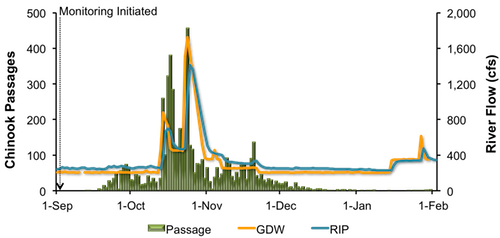
Figure 6. Daily upstream Chinook passage at the Stanislaus River weir in relation to daily average flows (cfs) recorded in the Stanislaus River at Goodwin (GDW) and Ripon (RIP), 2013.
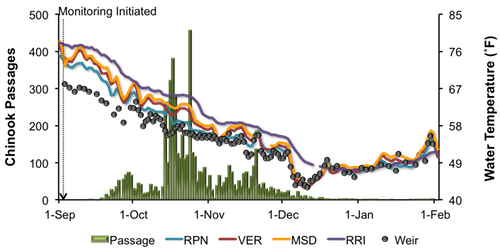
Figure 7. Daily upstream Chinook passage recorded at the Stanislaus River weir in relation to instantaneous water temperature recorded at the weir, and daily average water temperature recorded in the Stanislaus River at Ripon (RPN), and in the San Joaquin River at Vernalis (VER), Mossdale (MSD) and Rough & Ready (RRI) in 2013.
Figure 8. Daily upstream Chinook passage at the Stanislaus River weir in relation to instantaneous turbidity recorded at the weir in 2013.
Figure 9. Daily upstream Chinook passage at the Stanislaus River weir in relation to instantaneous dissolved oxygen recorded at the weir, and daily average dissolved oxygen recorded in the Stanislaus River at Ripon (RPN), and in the San Joaquin River at Mossdale (MSD) and Rough & Ready (RRI) in 2013.
|
2013 Tuolumne River Weir Adult Migration Monitoring
A total of 23 Chinook salmon were detected passing upstream of the Tuolumne River Weir (RM 24) between January 13 and February 2, increasing the season total to 3,738. Daily passage ranged between 0 and 4 Chinook salmon (Figure 10). Year-to-date passage is higher than any other year since monitoring began in 2009 (Table 7).
No O. mykiss have been detected at the Tuolumne River weir this season.
Daily average flow in the Tuolumne River ranged from 160 cfs to 167 cfs at La Grange (LGN; RM 50) and 185 cfs and 224 cfs at Modesto (MOD; RM 17). Note: flows downstream of La Grange may be higher than dam releases due to accretion and Dry Creek inflow.
Instantaneous water temperature measured at the weir ranged between 49.2˚F and 59.3˚F and daily average water temperature at Modesto (MOD; RM 17) ranged between 48.4˚F and 55.2˚F (Figure 11). Instantaneous turbidity ranged between 0.52 NTU and 3.11 NTU (Figure 12), and instantaneous dissolved oxygen ranged between 8.61 mg/L and 12.71 mg/L (Figure 13).
Table 7. Annual Fall-run Chinook salmon passage, 2009 - 2013.
Figure 10. Daily upstream Chinook passage at the Tuolumne River Weir in relation to daily average flows (cfs) recorded in the Tuolumne River at La Grange (LGN) and Modesto (MOD), and in the San Joaquin River at Maze Road Bridge (MRB) and Vernalis (VNS) in 2013.
Figure 11. Daily upstream Chinook passage at the Tuolumne River Weir in relation to instantaneous water temperature recorded at the weir, and daily average water temperature recorded in the Tuolumne River at Modesto (MOD) and in the San Joaquin River at Maze Road Bridge (MRB), Vernalis (VER), Mossdale (MSD) and Rough & Ready (RRI) in 2013.
Figure 12. Daily upstream Chinook passage at the Tuolumne River Weir in relation to instantaneous turbidity recorded at the weir in 2013.
Figure 13. Daily upstream Chinook passage at the Tuolumne River Weir in relation to instantaneous dissolved oxygen recorded at the weir, and daily average dissolved oxygen recorded in the San Joaquin River at Mossdale (MSD) and Rough & Ready (RRI) in 2013.
|
2013 Mokelumne River Fish Ladder Monitoring
Fall-run Chinook salmon returning to the Mokelumne River are counted annually by East Bay Municipal Utility District as they ascend the fish ladder at Woodbridge Dam. Video monitoring continued during the reporting period and 5 Chinook salmon were observed passing upstream of the dam between January 13 and January 21, increasing the season total to 12,277 (Figure 14). Daily passages ranged between 0 and 2 Chinook salmon. During the reporting period, daily average flow in the Mokelumne River ranged between 254 cfs and 258 cfs at Camanche Reservoir (CMN).
Figure 14. Daily upstream Chinook passage recorded at the Woodbridge Dam fish ladder in relation to daily average flows (cfs) recorded in the Mokelumne River at Camanche Reservoir (CMN) in 2013.
|
San Joaquin River Conditions
During the reporting period, flow in the San Joaquin River at Vernalis ranged from 682 cfs to 983 cfs (Figure 15). Water temperature in the San Joaquin River ranged from 48.9°F to 56.6°F at Vernalis, from 49.6°F to 56.8°F at Mossdale, and from 48.4°F to 51.6°F at Rough 'n Ready Island (Figure 16). Average daily dissolved oxygen (DO) in the San Joaquin River fluctuated from 10.2 mg/L to 11.5 mg/L in the deep-water ship channel (measured at Rough 'n Ready Island), and from 10.3 mg/L to 12.4 mg/L at Mossdale (Figure 17).
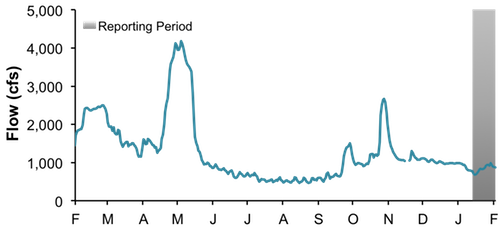
Figure 15. San Joaquin River flow at Vernalis from February 1, 2013, and February 2, 2014.
Figure 16. San Joaquin River daily average water temperature at Vernalis, Mossdale, and Rough 'n Ready from February 1, 2013, and February 2, 2014.
Figure 17. San Joaquin River daily average dissolved oxygen at Mossdale and Rough 'n Ready, from February 1, 2013, and February 2, 2014.
|
Delta Exports
Mean daily pumping at the C.W. Jones Pumping Plant (federal pumps previously known as Tracy Pumping Plant) ranged from 0 cfs to 805 cfs (Figure 18). Mean daily pumping at the Harvey O. Banks Pumping Plant (state pumps) ranged from 230 cfs to 1,492 cfs. Combined total exports (state and federal pumps) during this period ranged from 481 cfs to 1,642 cfs.
Figure 18. Daily exports at the state and federal pumping stations from February 1, 2013, and February 2, 2014.
|
|
|
|
|
|
|